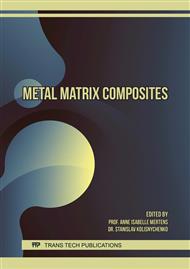p.47
p.53
p.59
p.65
p.73
p.79
p.87
p.94
p.100
Influence of the Process Parameters on the Penetration Depth of the Reinforcing Phase during Composite Peening for the Production of Functionally Graded Metal Matrix Composites
Abstract:
Composite peening describes a modified process based on micro shot peening. This process allows the controlled penetration of ceramic particles into areas of metallic matrix materials close to the surface layer. Composite material produced by composite peening promises a high application potential in the fields of lightweight, wear-resistant and durable materials. The use of ceramic reinforcing particles is expected to significantly improve thermal stability compared to conventional surface hardening processes. In addition, composite peening offers the possibility of cost-effectively reinforcing components and can even be applied subsequently in highly stressed surface layers. The material combination selected for this study was technically pure aluminum as model and matrix material and alumina as abrasive respectively reinforcement material. The influence on the particle density and the particle gradient was achieved by varying the process parameters, such as the process temperature and the peening pressure. A maximum penetration depth of almost 30 μm could be observed at high homologous temperatures. In light and scanning electron microscopy it was observed that the ceramic particles might break on impact with the surface of the blasting material. This causes a drastic reduction of the particle size, which initially had a size of 10 μm. This reduction of particle size promises advantages, particularly with cyclic loads.
Info:
Periodical:
Pages:
73-78
Citation:
Online since:
June 2019
Authors:
Keywords:
Price:
Сopyright:
© 2019 Trans Tech Publications Ltd. All Rights Reserved
Share:
Citation:



